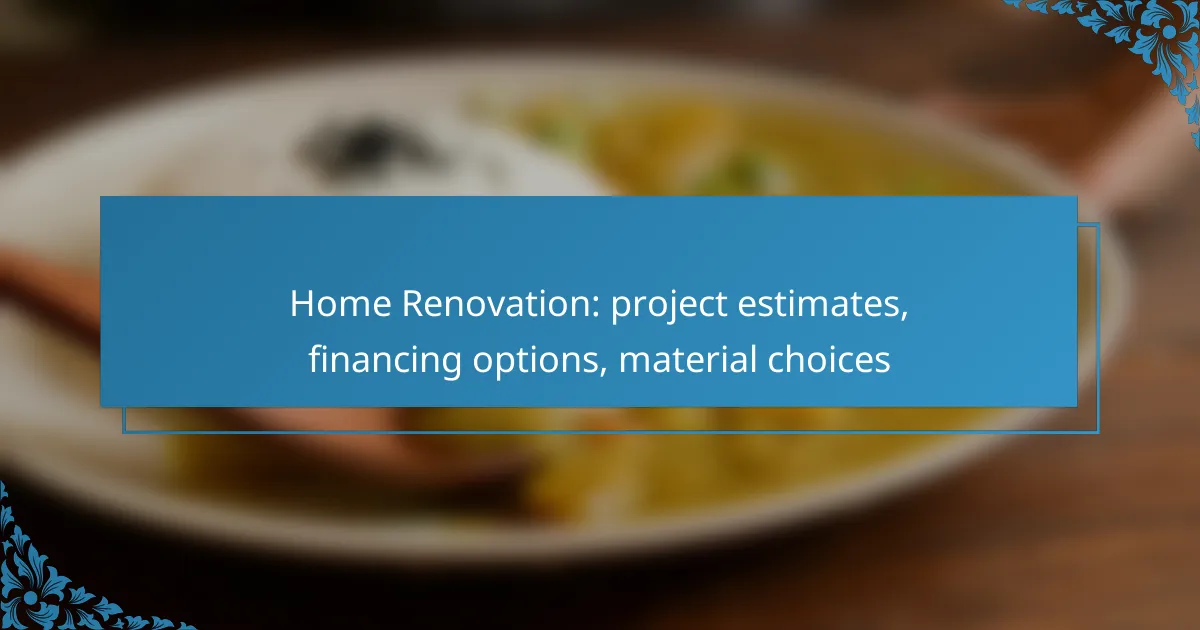Home renovation projects can be a significant investment, with costs in Australia often ranging from tens of thousands to over a hundred thousand dollars, depending on the project’s scope. To navigate this process effectively, homeowners should explore various financing options, such as home equity loans and personal loans, while carefully selecting materials that balance durability and cost. Proper budgeting and planning are essential to ensure a successful renovation that meets both aesthetic and functional needs.

What are the average costs for home renovation in Australia?
The average costs for home renovation in Australia can vary significantly based on the scope of the project, with typical expenses ranging from tens of thousands to over a hundred thousand Australian dollars. Homeowners should budget carefully, considering both materials and labor, to ensure a successful renovation.
Cost breakdown by project type
Different types of renovation projects come with varying costs. For example, a kitchen remodel may range from AUD 20,000 to AUD 50,000, while a bathroom renovation can cost between AUD 15,000 and AUD 30,000. Whole-home renovations typically start at around AUD 100,000 and can escalate based on size and complexity.
It’s essential to break down costs into materials, labor, and any permits required. This will provide a clearer picture of where the budget is allocated and help identify areas for potential savings.
Factors influencing renovation costs
Homeowners should also consider the time of year for renovations, as demand can affect pricing. Engaging with multiple contractors for quotes can help in finding the best value for the desired quality of work.
Regional cost variations in Australia
Renovation costs can vary widely across different regions in Australia. Major cities like Sydney and Melbourne generally have higher labor and material costs compared to regional areas. For instance, a kitchen renovation in Sydney might cost upwards of AUD 30,000, while the same project in a smaller town could be completed for around AUD 20,000.
Local regulations and building codes can also affect costs, as some areas may require specific permits or inspections that can add to the overall budget. It’s advisable to research local market conditions and consult with local contractors to get a more accurate estimate tailored to the specific location.

What financing options are available for home renovation?
Home renovation financing options include home equity loans, personal loans, and government grants or subsidies. Each option has distinct features, benefits, and considerations that can impact your renovation budget and overall financial strategy.
Home equity loans
Home equity loans allow homeowners to borrow against the equity they have built in their property. Typically, these loans offer lower interest rates compared to personal loans because they are secured by the home itself.
When considering a home equity loan, evaluate your current equity, which is the difference between your home’s market value and the remaining mortgage balance. Lenders often allow you to borrow up to 80% of your equity. Be mindful of the additional debt and ensure you can manage the repayments.
Personal loans
Personal loans are unsecured loans that can be used for home renovations without needing to leverage your home. These loans generally have higher interest rates than home equity loans but can be a good option for those without sufficient equity.
When applying for a personal loan, check your credit score, as this will significantly influence your interest rate. Loan amounts can vary widely, typically ranging from a few thousand to tens of thousands of dollars, depending on your creditworthiness and lender policies.
Government grants and subsidies
Government grants and subsidies for home renovation can provide financial assistance without the need for repayment. These programs often target specific improvements, such as energy efficiency upgrades or accessibility modifications.
To access these funds, research local and national programs that may be available. Eligibility requirements vary, and the application process can be competitive, so it’s essential to prepare your documentation thoroughly. Keep in mind that these grants may have specific conditions regarding the types of renovations covered.

How to choose the right materials for home renovation?
Choosing the right materials for home renovation involves balancing durability, cost, and environmental impact. Consider the specific needs of your project, including the intended use of the space and your budget constraints.
Durability and maintenance considerations
Durability is crucial when selecting materials for home renovation. Opt for materials that can withstand wear and tear, especially in high-traffic areas. For example, hardwood flooring may be more durable than carpet, but it requires regular maintenance to keep it looking its best.
Maintenance requirements can vary significantly between materials. For instance, natural stone countertops may need periodic sealing, while laminate surfaces are generally easier to clean and maintain. Assess how much time and effort you are willing to invest in upkeep before making your choice.
Cost-effective material options
Cost-effective materials can help you stay within budget while achieving your renovation goals. Consider alternatives like vinyl flooring instead of hardwood, which can offer a similar aesthetic at a fraction of the cost. Additionally, using reclaimed wood or recycled materials can provide savings while adding character to your space.
When evaluating costs, factor in both initial expenses and long-term savings. For example, energy-efficient windows may have a higher upfront cost but can lead to significant savings on heating and cooling bills over time.
Eco-friendly material choices
Eco-friendly materials are increasingly popular in home renovations due to their reduced environmental impact. Look for products made from sustainable resources, such as bamboo flooring or recycled metal roofing. These options not only help the planet but can also enhance your home’s appeal.
Additionally, consider materials with low volatile organic compounds (VOCs) to improve indoor air quality. Paints and finishes labeled as low-VOC or no-VOC can contribute to a healthier living environment. Research local suppliers for eco-friendly options that meet your renovation needs and budget.

What are the steps to get a home renovation estimate?
To obtain a home renovation estimate, start by engaging with contractors to discuss your project needs and budget. This process typically involves consultations, detailed scope creation, and comparing estimates from multiple providers.
Initial consultation process
The initial consultation is a crucial step where you meet with contractors to outline your renovation goals. During this meeting, discuss your vision, budget, and timeline, which helps contractors understand your expectations.
Be prepared to share any existing plans or ideas, as this will aid in generating a more accurate estimate. Ask questions about the contractor’s experience and previous projects to gauge their suitability for your renovation.
Detailed project scope creation
After the initial consultation, the contractor will create a detailed project scope, which outlines the specific tasks, materials, and timelines involved in the renovation. This document serves as a blueprint for the work to be done and is essential for accurate estimates.
Ensure that the scope includes all aspects of the renovation, such as demolition, construction, and finishing touches. Clear communication at this stage can prevent misunderstandings and unexpected costs later on.
Comparing multiple estimates
Once you have received estimates from several contractors, compare them carefully to identify the best fit for your project. Look beyond the total cost; consider the breakdown of materials, labor, and timelines provided in each estimate.
It’s helpful to create a comparison table that lists key components of each estimate, such as material quality, project duration, and payment terms. This will make it easier to evaluate which contractor offers the best value for your renovation needs.

What permits are required for home renovation in Australia?
In Australia, home renovation projects typically require various permits depending on the scope of work and local regulations. Commonly, building permits, planning permits, and sometimes specific permits for electrical or plumbing work are necessary to ensure compliance with safety and zoning laws.
Common permits for residential projects
Common permits for residential renovations include building permits, which are essential for structural changes, and planning permits, which address land use and zoning compliance. Additional permits may be required for specialized work, such as electrical or plumbing installations, depending on the local council’s regulations.
For example, if you are adding a room or making significant alterations to the exterior of your home, a building permit is likely mandatory. Always check with your local council to determine the specific permits needed for your project.
Local council regulations
Local council regulations vary significantly across Australia, affecting the type of permits required for home renovations. Each council has its own set of rules regarding building codes, zoning laws, and environmental considerations that must be adhered to.
Before starting your renovation, consult your local council’s website or office for guidelines specific to your area. This can help you avoid delays and ensure that your project meets all legal requirements.
Timeline for obtaining permits
The timeline for obtaining renovation permits in Australia can range from a few weeks to several months, depending on the complexity of the project and the efficiency of the local council. Simple projects may receive approval quickly, while larger renovations involving multiple permits can take longer.
To expedite the process, ensure that all required documentation is complete and accurate before submission. Engaging a professional, such as an architect or builder familiar with local regulations, can also help streamline the permit application process.

How to find reliable contractors for home renovation?
Finding reliable contractors for home renovation involves thorough research and careful consideration of various factors. Start by checking their credentials, seeking reviews, and interviewing potential candidates to ensure you select the right professional for your project.
Checking contractor credentials
Verify that contractors hold the necessary licenses and insurance required in your area. This typically includes general liability insurance and worker’s compensation to protect you from potential liabilities during the renovation.
Additionally, confirm their experience in home renovation projects similar to yours. A contractor with a strong track record in your specific type of renovation will likely deliver better results.
Reviews and recommendations
Look for online reviews on platforms like Google, Yelp, or specialized home improvement websites. Pay attention to both positive and negative feedback to get a balanced view of the contractor’s performance.
Ask friends, family, or neighbors for recommendations based on their experiences. Personal referrals can often lead to trustworthy contractors who have proven their reliability and quality of work.
Interviewing potential contractors
Prepare a list of questions to ask during interviews, focusing on their experience, project timelines, and payment structures. Inquire about their approach to managing unexpected issues that may arise during the renovation.
Request detailed estimates from multiple contractors to compare costs and services. This will help you understand the market rates and ensure you are getting a fair deal for your renovation project.
